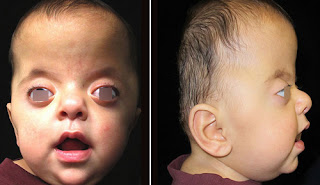What is Apert syndrome?
An Apert syndrome also known as Acrocephalosyndactyly syndrome is a genetic disorder that primarily affects the skull bones.
Its typical characteristic is a premature fusion of the skull bones, which prevents the skull from growing normally leading to a distorted shape of the head and face. The premature fusion also affects the bones of the fingers and toes. (1, 2, and 3)
References
Its typical characteristic is a premature fusion of the skull bones, which prevents the skull from growing normally leading to a distorted shape of the head and face. The premature fusion also affects the bones of the fingers and toes. (1, 2, and 3)
picture 1: An image of an infant with Apert syndrome.
image source: www.seattlechildrens.org
image source: www.seattlechildrens.org
picture 2: A six-month-old child with Apert syndrome.
image source: www.chop.edu
image source: www.chop.edu
picture 3: Children living with Apert syndrome.
image source: i.ytimg.com
image source: i.ytimg.com
picture 4: Webbed fingers as the classic manifestations of Apert syndrome.
image source: cdn1.medicalnewstoday.com
image source: cdn1.medicalnewstoday.com
picture 5: A malformation of the facial bones, which is a cardinal sign of Apert syndrome.
image source: medicleft.com
image source: medicleft.com
What causes Apert syndrome?
It is caused by a rare mutation of the single gene, which is responsible for helping bones to fuse together during the development stage. It is an extremely rare condition, which could take place in one out of 65,000 babies. (3, 4)Apert syndrome symptoms
- The skull bones fused prematurely and as the brain grows it puts pressure on the skull and face resulting in a long head and a high forehead.
- the middle face is sunken (5)
- wide-set bulging eyes
- recurrent ear and sinus infections
- hearing loss
- webbed fingers and/or toes
- obstructive sleep apnea
- delayed intellectual development
- urinary problems
- cardiac problems (3)
- gastrointestinal problems
Apert syndrome diagnosis
A diagnosis is made based on the newborn's appearance. If the doctor is suspecting an Apert syndrome, he will order genetic testing to be certain if it is really an Apert syndrome or something else. A thorough physical examination of the infant's skull and face will be done. To thoroughly view the skull and the bones in the hands and feet, an x-ray or CT scan is ordered. These procedures are done on the patient's first appointment to make sure that accurate diagnosis is made and that treatment and management will be started the soonest time possible. (5, 6, and 7)
picture 6: Webbed toes in a patient with Apert syndrome.
image source: wikimedia.org
image source: wikimedia.org
picture 7: Children with Apert syndrome need a healthy family environment.
image source: childrenshospital.org
image source: childrenshospital.org
picture 8: Severely distorted toes in a patient with Apert syndrome.
image source: escholarship.org
image source: escholarship.org
Apert syndrome treatment
Unfortunately, there is no cure for Apert syndrome. However, there are management procedures that can be done to significantly improve the patient's quality of life. Apert syndrome surgery is done to somehow improve the patient's condition and prevent further complications. A craniosynostosis release procedure is performed when a child is between ages six to eight months to separate abnormally fused skull bones and rearrange them. The patient also needs to be seen by a psychologist and a therapist to assist with speech, language, and overall development. The patient also needs to be seen by an ophthalmologist to check for any abnormalities. (7, 8, and 9)Apert syndrome prognosis
The prognosis is good if surgical procedures and management are given to the patient at a young age. If surgical procedures are performed at later years of life, there is a possibility that the patient will not be able to reach a normal intellectual ability. As a matter of fact, there is a possibility that some structures in the brain may remain poorly developed even after the surgery. Those with Apert syndrome have a normal life expectancy, especially if raised and being taken good care of by their parents. About four out of 10 children with Apert syndrome achieve a normal intellectual ability provided they are raised in a healthy family environment. (5, 9, and 10)References
- https://ghr.nlm.nih.gov/condition/apert-syndrome
- https://emedicine.medscape.com/article/941723-overview?pa=31xeFj49vgNM3cJtDXIlzCAz2jatqjM6VGof9FHCpXpJQ0pfd6S6qm0fpXjLn2JjF%2ByR4oC6ExspROMquIWgXMOTxXj1FB9%2Fm4TgsfVXs6o%3D
- https://en.wikipedia.org/wiki/Apert_syndrome
- https://rarediseases.org/rare-diseases/apert-syndrome/
- https://www.webmd.com/children/apert-syndrome-symptoms-treatments-prognosis#1
- http://www.seattlechildrens.org/medical-conditions/chromosomal-genetic-conditions/apert-syndrome/
- http://www.stlouischildrens.org/diseases-conditions/apert-syndrome
- https://www.healthline.com/health/apert-syndrome
- https://www.medicalnewstoday.com/articles/320907.php
- http://www.faces-cranio.org/Disord/Apert.htm









